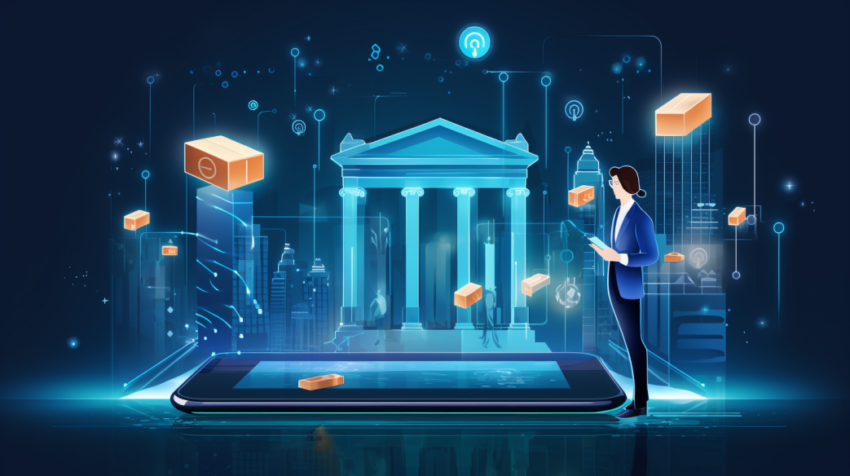The banking industry has long been at the core of global economies, and over the past few decades, technology has played an increasingly transformative role. From the advent of online banking to the rise of digital wallets, fintech innovations are reshaping how people interact with financial institutions and manage their money. Technology is no longer just a convenience in banking; it has become an essential component that is driving efficiency, improving customer experience, and even redefining the future of banking itself.
In this article, we will explore how technology is transforming the banking industry, looking at key innovations, such as digital banking, artificial intelligence (AI), blockchain technology, and automation, as well as their implications on customers and financial institutions. We will also answer seven frequently asked questions (FAQs) and conclude with key takeaways that highlight the most important trends and future developments in the banking sector.
1. The Rise of Digital Banking
Digital banking has redefined how we access and manage our money. With the rise of smartphones and high-speed internet, banking has become increasingly accessible from virtually anywhere. Digital banks, or “neobanks,” have emerged as fully online financial institutions that offer services such as savings accounts, checking accounts, loans, and credit cards—without the need for physical branches. These banks operate entirely through mobile apps and websites, offering users greater flexibility, convenience, and often lower fees compared to traditional banks.
The key to digital banking’s success is its ability to provide users with a seamless and highly convenient banking experience. For instance, customers can complete transactions, pay bills, check account balances, and apply for loans with just a few taps on their smartphones. Neobanks also leverage cloud computing and data analytics to offer personalized financial products and services based on user preferences and behavior, further enhancing the customer experience.
2. Artificial Intelligence and Machine Learning
Artificial Intelligence (AI) and machine learning (ML) are among the most significant technological advancements in banking today. AI and ML algorithms are used to streamline a variety of banking processes, improving operational efficiency and providing better services to customers. AI technologies are being deployed in fraud detection, credit scoring, customer service, and more.
One of the most notable uses of AI is in fraud detection. By analyzing large amounts of transaction data in real-time, AI can detect suspicious patterns and flag fraudulent activity quickly, reducing the risk of financial crime. Machine learning algorithms also improve the accuracy of credit scoring models, enabling banks to assess the creditworthiness of individuals and businesses more accurately and fairly.
Additionally, AI-driven chatbots and virtual assistants are enhancing customer service by providing 24/7 support, answering common queries, and assisting with tasks such as money transfers, account inquiries, and loan applications. This reduces the need for human intervention, allowing banks to allocate resources more efficiently and improving the overall customer experience.
3. Blockchain Technology and Cryptocurrencies
Blockchain technology, which underpins cryptocurrencies like Bitcoin and Ethereum, has the potential to revolutionize how banks handle transactions, particularly in the realm of cross-border payments and securities trading. The decentralized nature of blockchain allows for more secure, transparent, and efficient transactions by eliminating the need for intermediaries such as clearinghouses or correspondent banks. This can significantly reduce transaction costs and improve processing times.
For example, cross-border payments traditionally involve multiple intermediaries, which can be slow and costly. Blockchain technology enables direct peer-to-peer transactions that bypass traditional intermediaries, allowing for faster and cheaper cross-border payments. Major financial institutions have already begun exploring blockchain applications to enhance their payment systems, with some even launching their own blockchain-based payment platforms.
Additionally, the rise of cryptocurrencies has sparked a wave of innovation in the banking industry. Cryptocurrencies offer the potential for financial inclusion, as they can be used by individuals who may not have access to traditional banking services. Central banks around the world are also exploring the idea of Central Bank Digital Currencies (CBDCs), which could provide a digital version of fiat currency, further integrating blockchain technology into the mainstream financial system.
4. Automation and Robotic Process Automation (RPA)
Automation is one of the most impactful ways in which technology is transforming the banking industry. Robotic Process Automation (RPA) is being used to streamline routine, repetitive tasks, allowing banks to save time and reduce operational costs. RPA involves the use of software robots or “bots” to perform tasks such as data entry, account reconciliation, regulatory compliance checks, and transaction processing.
By automating these time-consuming tasks, banks can free up their human resources to focus on more complex and value-added activities, such as customer service, relationship management, and strategic decision-making. Additionally, RPA can help reduce human error, improve data accuracy, and increase the overall speed of operations. This leads to improved efficiency and better service delivery, all of which benefit customers and financial institutions alike.
5. Big Data and Analytics
The banking industry generates vast amounts of data, ranging from customer transaction histories to market trends and financial performance indicators. Big data analytics allows banks to harness this data to gain deeper insights into customer behavior, financial market trends, and operational performance.
For example, banks can use data analytics to identify customer preferences, predict future spending behaviors, and offer personalized financial products and services. This can lead to improved customer satisfaction and higher engagement rates. Banks are also using predictive analytics to detect fraud, assess credit risk, and optimize their lending strategies.
Moreover, big data allows for real-time decision-making, helping banks adapt to rapidly changing market conditions. By analyzing data in real time, banks can respond more effectively to market fluctuations, making more informed investment decisions and managing risks better.
6. Cloud Computing
Cloud computing has become a game-changer for the banking industry, offering banks the ability to store and process large amounts of data without the need for expensive on-premise infrastructure. Cloud services allow financial institutions to scale their operations efficiently, enhance data security, and reduce IT costs.
Cloud computing also enables banks to offer innovative financial services to customers. For instance, cloud-based solutions can be used to deliver mobile banking apps, provide real-time data analytics, and facilitate seamless transactions across multiple platforms. This flexibility and scalability allow banks to adapt quickly to changing market demands and customer needs.
7. Cybersecurity and Data Protection
As the banking industry becomes more reliant on technology, the importance of cybersecurity has grown exponentially. The increased volume of online and mobile transactions has made banks more vulnerable to cyberattacks, including data breaches, phishing attacks, and ransomware.
To address these threats, banks are investing heavily in advanced cybersecurity technologies, such as multi-factor authentication, biometric verification, and AI-powered threat detection systems. These technologies help protect sensitive customer data and prevent fraudulent activities, ensuring that banking services remain secure and trustworthy.
Moreover, the use of encryption and blockchain technology ensures that financial transactions and customer data are kept private and secure, further reducing the risk of cyber threats. With the growing importance of digital banking, cybersecurity will continue to be a key focus area for the industry.
7 Frequently Asked Questions (FAQs) About Technology and Banking
- How is technology improving the customer experience in banking? Technology is enhancing customer experience through digital banking platforms, AI-powered chatbots, personalized financial services, and improved transaction speed. Customers can access their accounts 24/7, receive tailored recommendations, and enjoy more seamless and efficient banking experiences.
- What is the impact of AI in banking? AI improves fraud detection, enhances customer service through virtual assistants, and helps banks make better lending decisions. It also allows for the automation of routine tasks, increasing operational efficiency and reducing human error.
- Is blockchain technology the future of banking? Blockchain has the potential to revolutionize banking by enabling faster, more secure transactions, particularly in cross-border payments. Many financial institutions are already exploring blockchain for payments and securities trading.
- How does automation help banks? Automation reduces the need for manual intervention in routine tasks, such as data entry and account reconciliation. This leads to greater efficiency, fewer errors, and lower operational costs, allowing banks to focus on more complex functions.
- Can technology help with financial inclusion? Yes, digital banking and blockchain technologies can provide access to financial services for people in underserved or remote areas, who may not have access to traditional banking infrastructure.
- What are the risks of relying on technology in banking? Increased reliance on technology can make banks more vulnerable to cyberattacks, data breaches, and system failures. It’s crucial for banks to invest in cybersecurity and disaster recovery measures to mitigate these risks.
- How will future banking evolve with technology? Future banking is expected to be more digital, automated, and personalized, with innovations like AI, blockchain, and open banking driving the transformation. Traditional banking models will likely be replaced by more agile and customer-centric platforms.
Conclusion
The banking industry is undergoing a profound transformation driven by technological advancements. From digital banking and AI to blockchain and automation, technology is reshaping how financial institutions operate, how they serve their customers, and how they navigate an increasingly complex financial landscape. These innovations are enhancing efficiency, improving customer experiences, and driving greater financial inclusion.
The future of banking will be characterized by an even greater integration of technology, offering customers more personalized, seamless, and secure financial services. Financial institutions must continue to embrace technological advancements to remain competitive and meet the evolving demands of their customers.
Key Takeaways:
- Digital Banking: The rise of digital-only banks and mobile banking platforms is changing how customers interact with financial institutions.
- AI and Automation: AI is revolutionizing customer service, fraud detection, and decision-making, while automation streamlines operations and reduces costs.
- Blockchain Technology: Blockchain is transforming cross-border payments and financial transactions by improving security, transparency, and speed.
- Big Data: Big data analytics allows banks to gain insights into customer behavior, optimize operations, and manage risks better.
- Cybersecurity: As banking becomes more digital, robust cybersecurity measures are crucial to protecting customer data and maintaining trust.
- Cloud Computing: Cloud technology offers scalability and flexibility, enabling banks to offer innovative services and reduce infrastructure costs.
- Financial Inclusion: Technology is improving access to financial services, allowing underserved populations to participate in the global economy.

